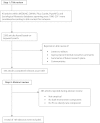The relationship between built environments and physical activity: a systematic review
- PMID: 22897546
- PMCID: PMC3490655
- DOI: 10.2105/AJPH.2012.300740
The relationship between built environments and physical activity: a systematic review
Abstract
Objectives: We conducted a systematic review of the literature examining the relationship between built environments (e.g., parks, trails, sidewalks) and physical activity (PA) or obesity rates.
Methods: We performed a 2-step inclusion protocol to identify empirical articles examining any form of built environment and any form of PA (or obesity rate) as the outcome. We extracted data from included abstracts for analysis by using a standard code sheet developed for this study.
Results: Of 169 included articles, 89.2% reported beneficial relationships-but virtually all articles utilized simple observational study designs not suited for determining causality. Studies utilizing objective PA measures (e.g., pedometer) were 18% less likely to identify a beneficial relationship. Articles focusing on children in community settings (-14.2%), those examining direct measures of obesity (-6.2%), or those with an academic first author (-3.4%) were less likely to find a beneficial relationship.
Conclusions: Policymakers at federal and local levels should encourage more rigorous scientific research to determine whether altered built environments will result in increased PA and decreased obesity rates.
Figures
References
-
- Flegal KM, Carroll MD, Ogden CL, Curtin LR. Prevalence and trends in obesity among US adults, 1999–2008. JAMA. 2010;303(3):235–241 - PubMed
-
- Ogden CL, Carroll MD, Curtin LR, Lamb MM, Flegal KM. Prevalence of high body mass index in U.S. children and adolescents, 2007–2008. JAMA. 2010;91(3):519–527 - PubMed
-
- Wang Y, Beydoun MA. The obesity epidemic in the United States—gender, age, socioeconomic, racial/ethnic, and geographic characteristics: a systematic review and meta-regression analysis. Epidemiol Rev. 2007;29:6–28 - PubMed
-
- Centers for Disease Control and Prevention Differences in prevalence of obesity among Black, White, and Hispanic adults—United States, 2006–2008. MMWR Morb Mortal Wkly Rep. 2009;58(27):740–744 - PubMed
-
- Shields M, Tjepkema M. Regional differences in obesity. Health Rep. 2006;17(3):61–67 - PubMed
Publication types
MeSH terms
Grants and funding
LinkOut - more resources
Full Text Sources


